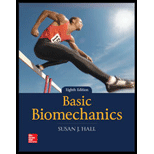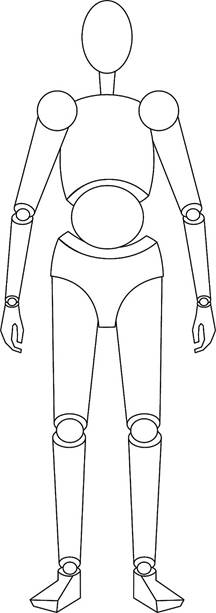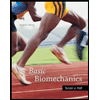
Concept explainers
If you had to design a model of the human body composed entirely of regular geometric solids, which solid shapes would you choose? Using a straightedge, sketch a model of the human body that incorporates the solid shapes you have selected.
To explain: The model of human body with different solid shapes.
Concept introduction: In general, human body is made of segments in irregular shapes and diverse mass distributions. Human body is made of bone, muscles, and fat that have different densities and distributed unevenly in individuals.
Explanation of Solution
Some investigators modeled the human body using different geometric solids. This helps an individuals to calculate the moment of inertia for regularly shaped solid substances. Fig.1 represent the model of human body that incorporates the solid shapes using s straightedge.

Fig.1: Model of human body using different solid shapes.
The solid shapes that are used to construct the model of human body are given below:
- Head is elliptical in shape.
- The neck region is slender cylindrical in shape.
- Scapula and clavicle are joined together in circle shaped articulating bones.
- Trunk part of the human body is cylinder in shape.
- The abdomen region is spherical in shape.
- Humerus, ulna, radius, femur, tibia, and fibula bones on the hands and legs are cylindrical in shape.
- The pelvic region of the human model is in cone shape.
- Elbows, tendons, and joints are spherical in shape.
- Feet resemble pentahedron shape.
Want to see more full solutions like this?
Chapter 14 Solutions
BASIC BIOMECHANICS
- Define cubitaarrow_forwardcome up with two illustrations of objects that exhibit patterns in nature and write a brief explanation ( 3 to 5 sentences) for each object illustrated.arrow_forwardYou have become good friends with a fellow student in your organic chemistry class. They are a chemistry major, and don't plan on taking anatomy, but they are often interested in hearing you discuss your knowledge of the body. After our talk on spinal cord injury, you decide to ask your friend about their own anatomy, since they happen to be in a wheelchair. Your friend decides to put you to the test, and explains the way they function in their kitchen, so you can guess their level of injury. They can get dishes in and out of the dishwasher, open and close the oven, grab the big jug of milk out of the refrigerator, and put a heavy casserole from the counter into the oven to bake. They love to make bread from scratch, and they enjoy vigorously kneading the bread. After dinner, your friend will move from their wheelchair into the recliner, and they use their upper body only to transfer their body weight and legs. Based on this information, which functioning pair of spinal nerves? C8 L5…arrow_forward
- Identify the structures from Figure (a) and (b) on a model or chart.arrow_forwardWhen it comes to living beings, how does the adage "the whole is more than the sum of its parts" apply? Give an examplearrow_forwardThe anatomical planes of the human body are represented by the varied angles at which the pears are sliced. Complete the gaps with the appropriate body plane.?arrow_forward
- Aside from its organization, what are the othercharacteristics or functions of the human body?Give one (1) with an examplearrow_forwardConsider a phosphorus atom that is part of the membrane of the sarcoplasmic reticulum in the biceps muscle of your arm. Using the levels of structural organization, name in order the structure that corresponds to each level of organization. Begin at the atomic level (the phosphorus atom) and end at the organ system level.arrow_forwardThe smallest independently functioning unit of an organism is a(n)arrow_forward
- There are several levels that describe biological organization. Tell me what these levels are and how they connect to each other and how they are important for a life system.arrow_forwardUsing the terms of position and direction, illustrate the various planes of the body. Your illustration should include the following terms: Cranial, Caudal, Ventral, Dorsal, Sagittal plane, Median section, Transverse section, Lateral and Frontal (coronal section).arrow_forwardCan you help me identify what this structure is and the parts of it?arrow_forward

 Basic BiomechanicsBioengineeringISBN:9780073522760Author:Susan J HallPublisher:McGraw-Hill Education
Basic BiomechanicsBioengineeringISBN:9780073522760Author:Susan J HallPublisher:McGraw-Hill Education

